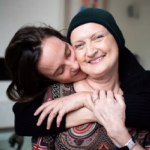How creativity has helped Lou throughout lockdown, and her brain tumour journey
Since the start of the Coronavirus pandemic last year, the pace of life as we had previously known it suddenly slowed down; similar to how many people feel when suddenly faced with a brain tumour diagnosis. Lou Henry, who was diagnosed with a meningioma in 2018, having previously also been diagnosed with Chronic Fatigue Syndrome in 2010, used the time in lockdown to get stuck into some creative projects and teach herself some new skills – a thought that may feel daunting at first, but as Lou explains, it needn’t be.
“Since lockdown last year I had noticed that my memory and ability to understand instructions was getting worse. I had read that learning new things can help new brain cells to grow and keep the memory sharp so, I decided to use the time to start some new creative projects. Art and creativity is something that I have always enjoyed but in this time of isolation, I have found myself learn some new skills that I did not know I had. It can feel daunting to try something new, but it is also so exciting when something I painted or made turns out better than I imagined it would.”
One such project that Lou started was watercolour painting; an activity that she has also been able to take part in with her young granddaughter.
At the start of lockdown, Lou and her granddaughter started doing joint art projects together over FaceTime and due to the government introducing childcare bubbles, they have now been able to expand their creativity and have some new projects lined up that they can do together.
When it comes to getting inspiration for her next project, Lou has found a lot of use in looking online for tips, scouring Pinterest and YouTube for ideas and guides, as well as TV, DIY programmes and books.
Some examples of the many things that Lou has created include Christmas, birthday and sympathy cards for family and friends and she likes to keep a log of everything she makes so she can see her progress.
“My confidence and enjoyment have improved when I create something new, such as the personalised cards. They can be simple or complicated but are made from the heart and are personalised, so I feel connected to each person I am making them for.”
‘Art is magical to me’

Lou has found expanding her creativity an incredibly rewarding experience and says that when she is in the moment of making something new, it allows her to focus on what she is doing in that moment, rather than other things that she may be worrying about.
“I am no expert but I feel that anyone can do it if I can. It has done me good to put my mind to something and look outwards rather than worrying inwards. Art is magical to me. It can start off with a blob of paint that turns into something recognisable in front of your eyes. My advice to somebody wanting to start a new creative project would be to start off small and don’t worry if it isn’t perfect- nothing is perfect. Anything is possible”.
Explore how creativity can help you on your brain tumour journey
This year, we’re theming Brain Tumour Awareness Month around self-care. Real self-care, not just bubble baths and some scented candles (although if they work for you, then great!)! Did you know that art and creativity is a fantastic way to unwind, relax and recharge – even if you’re a complete beginner?
That’s why we’re launching The Great brainstrust Create-Off, our brand new competition open to all ages and abilities. Are you ready to create your masterpiece?
Whether you’re living with the effects of a brain tumour, or you’re caring for a loved one, your well-being couldn’t be more important. By dedicating some time to this project, you’ll explore what makes you one of a kind as you put your personality on paper.
Get creative. Be inspired. Have fun. Join us as we dedicate this month to the 60,000 people living with a brain tumour here in the UK.












